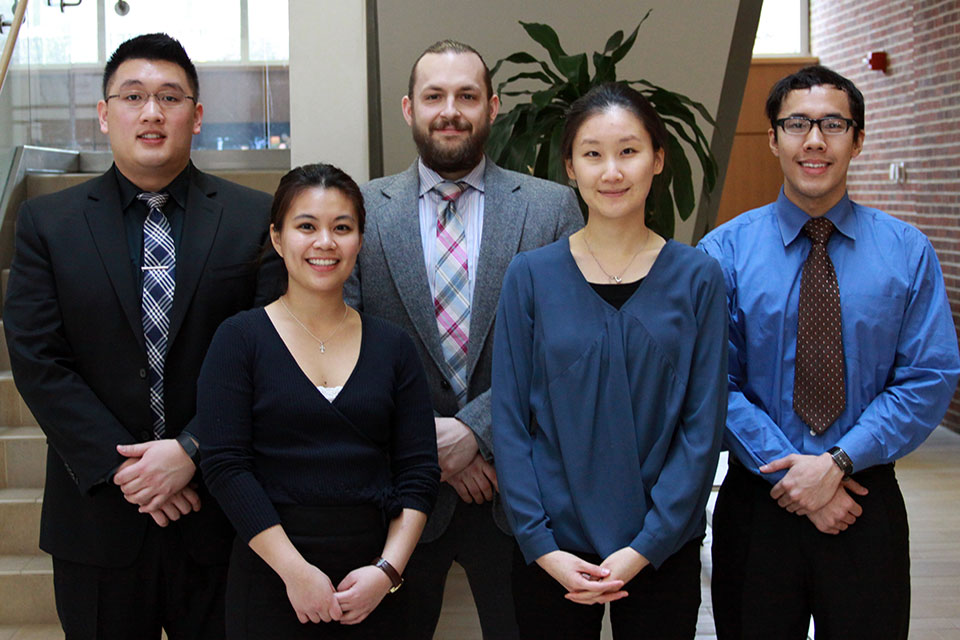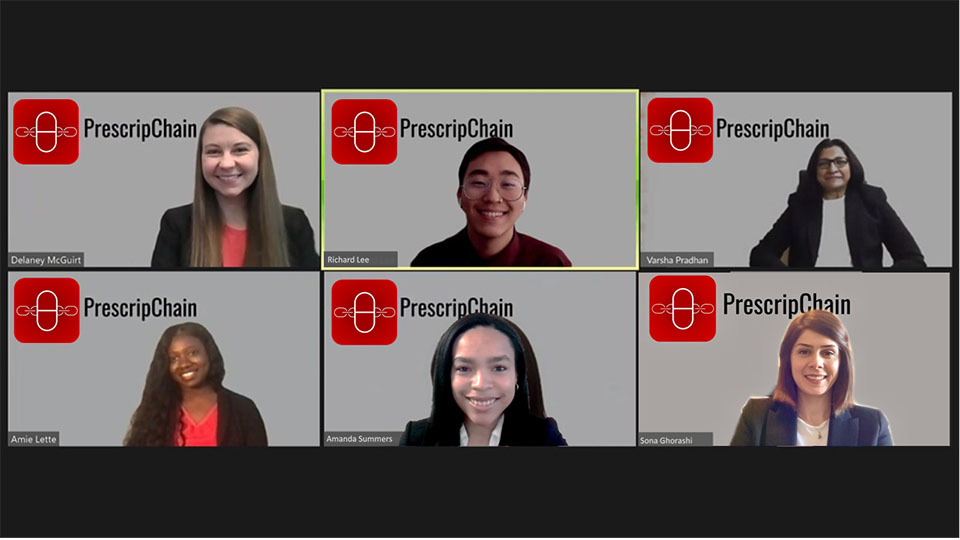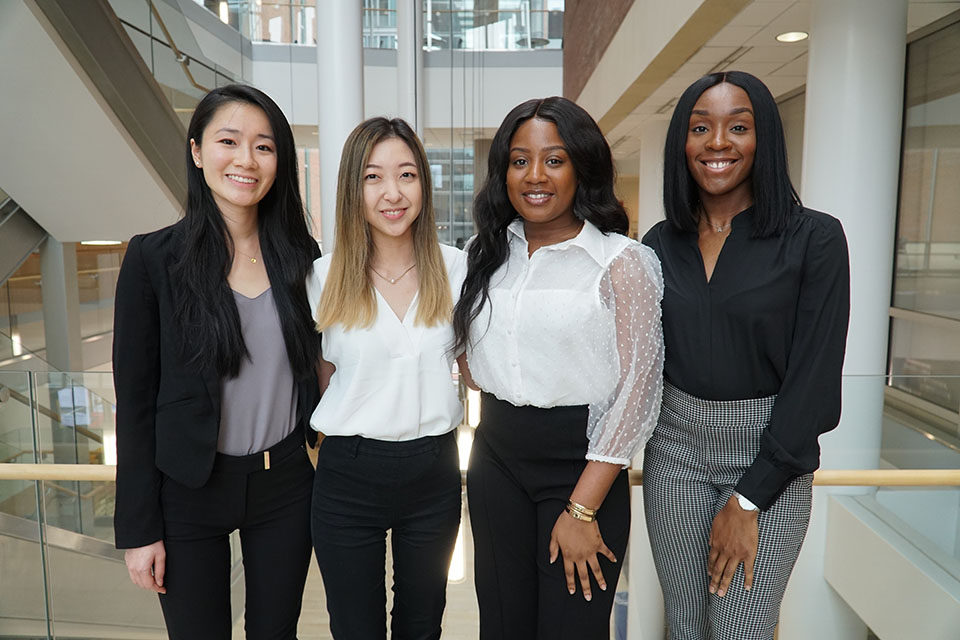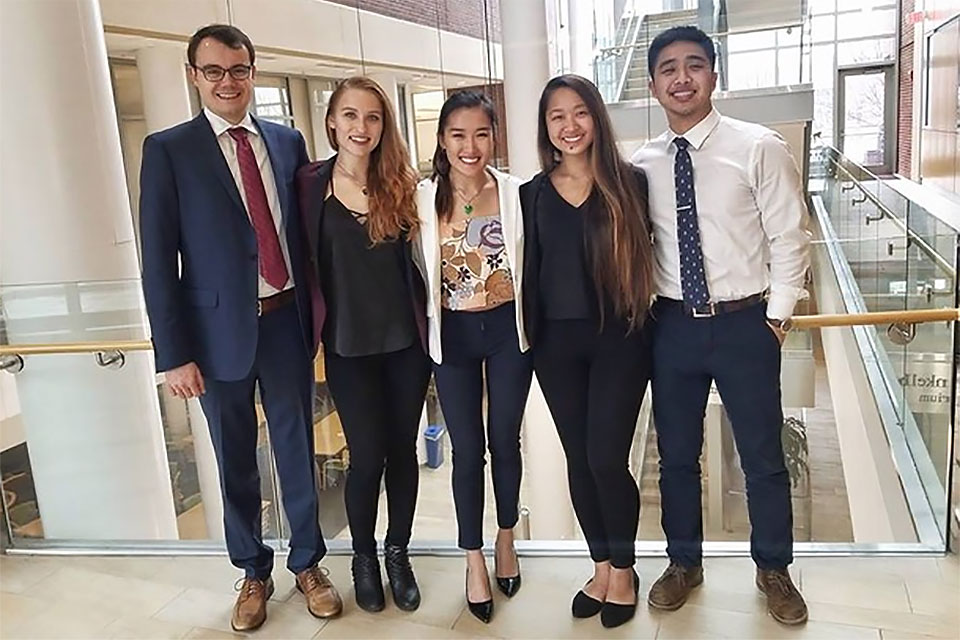SOP Talent Competition Brings Student Innovation to the Forefront
Fourth annual M-CERSI “America’s Got Regulatory Science Talent” competition awards third-year student pharmacists first prize for novel solution to improve FDA’s post-marketing surveillance program.

By Malissa Carroll
February 19, 2016
Imagine being a patient who has been prescribed a new medication. You take the medication as prescribed and, while it relieves your initial symptoms, you begin to notice a new symptom that you think might be caused by the medication itself – a side effect. To whom do you turn? Your health care provider? Your local pharmacist? Your family members and friends? Not according to team M-PROVE, a group of five third-year student pharmacists at the University of Maryland School of Pharmacy – including Jillian Aquino, Peter Nguyen, Justin Penzenstadler, David Tran, and Yoon Duk Hong – who took first place in the fourth annual “America’s Got Regulatory Science Talent” competition hosted by the University of Maryland’s Center of Excellence in Regulatory Science and Innovation (M-CERSI) on Feb. 5.
“Generally speaking, the first action that patients take when they believe they are experiencing an adverse reaction or side effect from a new medication is to conduct a Google search,” said Nguyen. “Our goal is to capitalize on patients’ fondness for Google to help them take a more proactive role in their health care and increase their participation in the Food and Drug Administration’s (FDA) pharmacovigilance efforts.”
The FDA boasts one of the most rigorous drug approval processes in the world. One component of this process involves ongoing safety monitoring based on information collected about medications and other medical products once they are made available to the public. In 1993, the agency launched MedWatch, its safety information and adverse event reporting program, to encourage patients to report firsthand any adverse reactions that they believe were caused as a result of a medication or other medical product. However, due to a lack of public awareness about this program, as well as patients’ perceptions of the amount of time and effort that it might require to make a report, MedWatch is not widely used, capturing only an estimated one in 10 adverse events.
“Participation is inversely proportional to perceived effort,” explained Penzenstadler, who described the team’s proposal to the audience. “When patients first visit the MedWatch website and see the lengthy reporting form, they often feel intimidated. However, we found that MedWatch requires only a minimal amount of information from patients, including the medication name, the adverse reaction experienced, and a unique patient identifier. Our proposed solution would enhance the existing MedWatch program to help identify more adverse events in the community.”
To help improve the MedWatch program and address an important goal of the FDA’s Office of Regulatory Science and Innovation — harnessing diverse data through information sciences to improve health outcomes — the team suggested leveraging the power of the world’s most popular search engine to bring the MedWatch adverse event reporting form to the forefront of patients’ search results. According to the team’s proposal, when an individual uses Google to search for a medication or adverse events associated with that medication, one of the items that would appear in the right sidebar of his or her search results would be the MedWatch reporting form. Individuals could enter the required information and submit a report without leaving their search results.
“It is a simple addition to an already well-implemented feature that displays in the search results for all Google users,” said Tran, who described the significance and impact that the team’s proposal could have on patients’ health care. “The patient’s query would be automatically inputted into a MedWatch form and submitted directly to the FDA. It would maximize the number of patient-reported outcomes submitted to the FDA, as well as improve the agency’s overall vigilance efforts.”
Hong added, “Our ultimate goal is to protect public safety and well-being. Because our proposed solution will make more data available to the FDA, it will allow the agency to detect adverse events more quickly, as well as better identify those populations that are more at risk for developing those side effects.”
Judges Andrew Coop, PhD, professor in the Department of Pharmaceutical Sciences (PSC) at the School of Pharmacy; Julia Slejko, PhD, assistant professor in the Department of Pharmaceutical Health Services Research (PHSR) at the School; and Jace Jones, PhD, research assistant professor in PSC, agreed with the group, awarding them first place and the chance to meet with staff at the FDA to further discuss their proposal.
Four teams competed in the talent competition this year, with second place awarded to Max Elixirs – a team of eight third-year student pharmacists who proposed creating a database that could serve as a resource for health care providers who prescribe biologics to their patients. The team also competed in the third annual “America’s Got Regulatory Science Talent” competition at the School in 2015 under the name One Correction, where members placed second again for their proposal to use QR codes to help educate patients about the potential risks associated with their medications.
“It means a great deal to be recognized as one of the top teams in the competition for the past two years,” says Joyce Yu, a third-year student pharmacist and team captain for Max Elixirs. “As student pharmacists, we are trained to educate both patients and health care providers about medication safety, and each year, this competition has afforded us a unique opportunity to develop innovative solutions to help address areas in patient and health care provider education where we feel gaps exist, allowing us to bring the role of pharmacists as leaders in medication information dissemination to the forefront.”
In addition to M-PROVE and Max Elixirs, FDAngerous – a seven-person team that included third- and fourth-year student pharmacists, as well as a graduate student from the PhD in PSC program – presented their proposal highlighting the benefits of transitioning to continuous manufacturing across the pharmaceutical industry, and New Generation Regulation – a team of four second-year student pharmacists – advocated to include a description and photo of medications on their prescription label.
“Pharmacists make up the second largest group of employees at the FDA, and the quality of the presentations delivered by our student pharmacists and biomedical scientists today underscores the value that these important health care professionals can add to that prestigious agency,” says James Polli, PhD, the Shangraw/Noxell Endowed Chair in Industrial Pharmacy and Pharmaceutics at the School and co-principal investigator for M-CERSI. “When we established this competition four years ago, our goal was to provide more students with an opportunity to get involved and learn about regulatory science. Not only have we accomplished that goal, but the student teams continue to astonish our judges with the tremendous effort that they put into their presentations, making for a very fun competition each year.”



